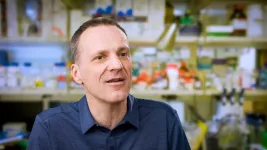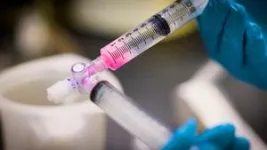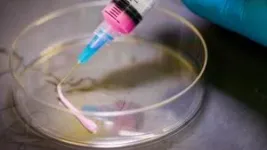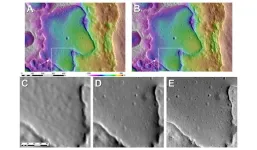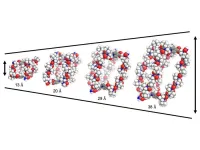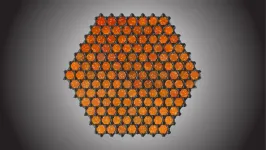(Press-News.org) SEATTLE — May 29, 2024 — Foam mixed with medications is already used to treat conditions such as varicose veins, hemorrhoids, wounds on the skin and even hair loss. Now, Fred Hutch Cancer Center scientists have found that foam might also be used as a vehicle to deliver expensive gene therapies.
Published May 28 in Nature Communications, bioengineer Matthias Stephan, MD, PhD, and his Fred Hutch team report that a foaming liquid worked better than a standard liquid formulation at transferring gene therapy components to cells in laboratory studies.
“Gene therapies are the new wave of medicine, but they are extremely expensive and difficult to make,” said Stephan, a professor in the Translational and Therapeutics Division at Fred Hutch. “Our gene therapy foam shows for the first time that by taking a small amount of an expensive gene therapy drug, increasing its volume by embedding it in a solution that is mostly made of densely packed air bubbles and then applying it to cells, we can achieve a strong and safe transfer of gene therapy agents to cells.”
Gene therapies in development for cancers, infectious diseases, inherited disorders and other diseases hold tremendous promise for providing long-lasting treatments by fixing the underlying biology. However, they also face major barriers including getting the therapies to the parts of the body where they’re needed and the high cost of making laboratory-modified viruses called vectors that deliver therapies to diseased cells. Foam could be the key to delivering gene therapies more simply and cheaply.
While the study is proof-of-concept, Stephan envisions the gene therapy foam as a possible solution for treating cancers that are in confined spaces, such as ovarian, pancreatic and gastrointestinal cancer and autoimmune diseases that affect the digestive system.
Watch video demonstration of the foam: https://www.youtube.com/watch?v=Esjh1xoriEA
“The foam could be applied to confined spaces to push again body tissues that have the disease, and the medication in the foam could adhere to those diseased cells,” Stephan explained. “Then as the air bubbles pop, the liquid with the gene therapy can drain away.”
Stephan has used other materials, such as nanoparticles and a tiny implantable sponge, to deliver genetic instructions to fight disease directly to cells. Looking for a new delivery vehicle, he was inspired by shaving foam.
“Foam is mostly gas bubbles separated by thin liquid films and it is already safely used in medicines and the food industry,” Stephan said. “We have not seen foam used with genetic materials, and I wondered if it could help solve the problem of gene therapy delivery.”
In the lab
In a series of lab experiments, Stephan and his team examined whether they could take a small amount of very expensive gene therapy vectors, mix them with gene editing materials and different foaming agents, and then apply the mixture to cells to see if the cells would take up the gene edits.
To test their approach, the team used another immune-based therapy: the mRNA for a COVID-19 vaccine, which teaches the immune system to attack the virus by showing the immune system the biological code for what the virus looks like.
The Fred Hutch team made their own solution of a COVID-19 mRNA vaccine with a biological tweak that allowed it to glow once it was delivered to cells. This way, once the lab-engineered gene therapy product was taken up by cells, the team could see it using a microscope.
To develop the foam, the team determined methylcellulose, a food additive used in ice cream and other products, created the best foam for transferring gene therapy product to cells and stayed in place where it was deposited.
When the team mixed the foam with cells, the foam substantially boosted gene transfer and outperformed liquid formulations. Then, when the team injected a small amount of foam into the abdominal cavity of mice, within one day the gene therapy transferred from the foam to the targeted cells without significant side effects.
Beyond the lab
The technology is many years from being used in people. Stephan hopes to attract external academic and industry collaborators to further develop the approach.
“The goal of my work is to make modern medicines work better for people everywhere,” Stephan said. “I believe that our future medical breakthroughs will arise from our deep understanding of disease biology and our knack for finding innovative solutions in unexpected places.”
Note: Scientists at Fred Hutch played a role in developing these discoveries, and Fred Hutch and certain of its scientists may benefit financially from this work in the future.
###
Media contact:
Molly McElroy
mwmcelro@fredhutch.org
Fred Hutchinson Cancer Center unites individualized care and advanced research to provide the latest cancer treatment options while accelerating discoveries that prevent, treat and cure cancer and infectious diseases worldwide.
Based in Seattle, Fred Hutch is an independent, nonprofit organization and the only National Cancer Institute-designated cancer center in Washington. We have earned a global reputation for our track record of discoveries in cancer, infectious disease and basic research, including important advances in bone marrow transplantation, immunotherapy, HIV/AIDS prevention and COVID-19 vaccines. Fred Hutch operates eight clinical care sites that provide medical oncology, infusion, radiation, proton therapy and related services. Fred Hutch also serves as UW Medicine’s cancer program.
END
Could a medicated foam make gene therapies more accessible?
In Nature Communications, Fred Hutch bioengineer Matthias Stephan, MD, PhD, reports latest effort to use innovative materials to improve immune-based therapies. See video: https://www.youtube.com/watch?v=Esjh1xoriEA
2024-05-29
ELSE PRESS RELEASES FROM THIS DATE:
Lehigh University researchers secure $2.5M DOE grant to characterize, extract rare earth elements from utility waste
2024-05-29
The waste generated by power generation utility companies could be a potential source of metals and minerals that are key components of modern electronics, batteries, vehicles, and the clean-energy industry as a whole.
Zheng Yao, principal research scientist within Lehigh University’s Energy Research Center (ERC), and a multidisciplinary team of researchers recently received a $2.5 million grant from the Department of Energy (DOE) to identify rare earth elements (REEs) and elements of interest (EOIs) in wastewater and solid waste streams, and to develop the technology that could extract those elements.
The project team includes ...
National Science Board elects first industry leader in 30 years
2024-05-29
Darío Gil, Ph.D., IBM Senior Vice President and Director of Research and a member of the Board of Trustees for Rensselaer Polytechnic Institute (RPI), has been elected chair of the National Science Board (NSB).
The NSB is the governing board of the National Science Foundation (NSF) and adviser to Congress and the President on policy matters related to STEM research and STEM education.
“Darío Gil’s insights and innovative thinking will be indispensable to his leadership of the NSB,” said RPI President Martin A. Schmidt, Ph.D. “His election speaks volumes about his exceptional talents ...
New technique from Brown University researchers offers more precise maps of the Moon’s surface
2024-05-29
PROVIDENCE, R.I. [Brown University] — A new study by Brown University researchers may help redefine how scientists map the surface of the Moon, making the process more streamlined and precise than ever before.
Published in the Planetary Science Journal, the research by Brown scholars Benjamin Boatwright and James Head describes enhancements to a mapping technique called shape-from-shading. The technique is used to create detailed models of lunar terrain, outlining craters, ridges, slopes and other surface hazards. By analyzing the way light hits different surfaces of the Moon, it allows researchers to estimate the three-dimensional ...
Dariusz Stramski selected as 2024 recipient of the Nils Gunnar Jerlov Medal
2024-05-29
Professor Dariusz Stramski of Scripps Institution of Oceanography at UC San Diego has been selected by The Oceanography Society as the 2024 recipient of the Nils Gunnar Jerlov Medal in recognition of his significant and wide-ranging contributions to the field of optical oceanography.
With a distinguished career spanning over 40 years, Dr. Stramski has made profound impacts on the study of ocean optics. Born in Poland, Stramski received his M.S. with honors in oceanography (1978) and Ph.D. in Earth ...
AI health coach lowers blood pressure and boosts engagement in patients with hypertension
2024-05-29
(Toronto, May 28, 2024) A new study in JMIR Cardio, published by JMIR Publications, shows that a fully digital, artificial intelligence (AI)–driven lifestyle coaching program can effectively reduce blood pressure (BP) in adults with hypertension. This AI-based program leverages data from wearable activity trackers and BP monitors as well as a mobile app questionnaire to tailor lifestyle guidance. The research team, led by Jared Leitner of the University of California, San Diego, used this innovative intervention to help manage ...
AI saving humans from the emotional toll of monitoring hate speech
2024-05-29
A team of researchers at the University of Waterloo have developed a new machine-learning method that detects hate speech on social media platforms with 88 per cent accuracy, saving employees from hundreds of hours of emotionally damaging work.
The method, dubbed the Multi-Modal Discussion Transformer (mDT), can understand the relationship between text and images as well as put comments in greater context, unlike previous hate speech detection methods. This is particularly helpful in reducing false positives, which are often ...
Chicken feathers to deliver chemotherapy drugs and repair enzymes
2024-05-29
A new method of drug delivery using proline, an amino acid found in chicken feathers and skin tissue, could be used to limit the side effects of chemotherapy and repair important enzymes, new research suggests.
Published in the journal Chem today, researchers have designed a cage (a box made of single molecules) from biologically compatible peptides, short amino acids that form the basis of proteins. These cages can house drugs of different sizes and transport them in the body with high levels of precision.
The negative ...
Bio-inspired cameras and AI help drivers detect pedestrians and obstacles faster
2024-05-29
It’s every driver’s nightmare: a pedestrian stepping out in front of the car seemingly out of nowhere, leaving only a fraction of a second to brake or steer the wheel and avoid the worst. Some cars now have camera systems that can alert the driver or activate emergency braking. But these systems are not yet fast or reliable enough, and they will need to improve dramatically if they are to be used in autonomous vehicles where there is no human behind the wheel.
Quicker detection using less computational ...
Graphene gets cleaned up
2024-05-29
Graphene has been called “the wonder material of the 21st century.” Since its discovery in 2004, the material—a single layer of carbon atoms—has been touted for its host of unique properties, which include ultra-high electrical conductivity and remarkable tensile strength. It has the potential to transform electronics, energy storage, sensors, biomedical devices, and more. But graphene has had a dirty little secret: it's dirty.
Now, engineers at Columbia University and colleagues at the University of Montreal and the National Institute of Standards and Technology are poised to clean things up with an oxygen-free chemical vapor ...
Study finds older adults hospitalized for heart failure had high risk of kidney complications
2024-05-29
In a study of Medicare beneficiaries, researchers from Brigham and Women’s Hospital found that one year after hospitalization for heart failure, 6 percent of patients had progressed to dialysis.
KEY TAKEAWAYS
Study led by Brigham researchers found that among older adults hospitalized for heart failure, nearly 3 in 4 were discharged with reduced kidney function.
Lower kidney function was associated with substantially higher risk of kidney complications and other adverse clinical outcomes among older adults, with more than 1 in 20 progressing to dialysis within one year after heart failure hospitalization.
These findings emphasize the need ...
LAST 30 PRESS RELEASES:
Eye for trouble: Automated counting for chromosome issues under the microscope
The vast majority of US rivers lack any protections from human activities, new research finds
Ultrasound-responsive in situ antigen "nanocatchers" open a new paradigm for personalized tumor immunotherapy
Environmental “superbugs” in our rivers and soils: new one health review warns of growing antimicrobial resistance crisis
Triple threat in greenhouse farming: how heavy metals, microplastics, and antibiotic resistance genes unite to challenge sustainable food production
Earthworms turn manure into a powerful tool against antibiotic resistance
AI turns water into an early warning network for hidden biological pollutants
Hidden hotspots on “green” plastics: biodegradable and conventional plastics shape very different antibiotic resistance risks in river microbiomes
Engineered biochar enzyme system clears toxic phenolic acids and restores pepper seed germination in continuous cropping soils
Retail therapy fail? Online shopping linked to stress, says study
How well-meaning allies can increase stress for marginalized people
Commercially viable biomanufacturing: designer yeast turns sugar into lucrative chemical 3-HP
Control valve discovered in gut’s plumbing system
George Mason University leads phase 2 clinical trial for pill to help maintain weight loss after GLP-1s
Hop to it: research from Shedd Aquarium tracks conch movement to set new conservation guidance
Weight loss drugs and bariatric surgery improve the body’s fat ‘balance:’ study
The Age of Fishes began with mass death
TB harnesses part of immune defense system to cause infection
Important new source of oxidation in the atmosphere found
A tug-of-war explains a decades-old question about how bacteria swim
Strengthened immune defense against cancer
Engineering the development of the pancreas
The Journal of Nuclear Medicine ahead-of-print tip sheet: Jan. 9, 2026
Mount Sinai researchers help create largest immune cell atlas of bone marrow in multiple myeloma patients
Why it is so hard to get started on an unpleasant task: Scientists identify a “motivation brake”
Body composition changes after bariatric surgery or treatment with GLP-1 receptor agonists
Targeted regulation of abortion providers laws and pregnancies conceived through fertility treatment
Press registration is now open for the 2026 ACMG Annual Clinical Genetics Meeting
Understanding sex-based differences and the role of bone morphogenetic protein signaling in Alzheimer’s disease
Breakthrough in thin-film electrolytes pushes solid oxide fuel cells forward
[Press-News.org] Could a medicated foam make gene therapies more accessible?In Nature Communications, Fred Hutch bioengineer Matthias Stephan, MD, PhD, reports latest effort to use innovative materials to improve immune-based therapies. See video: https://www.youtube.com/watch?v=Esjh1xoriEA
